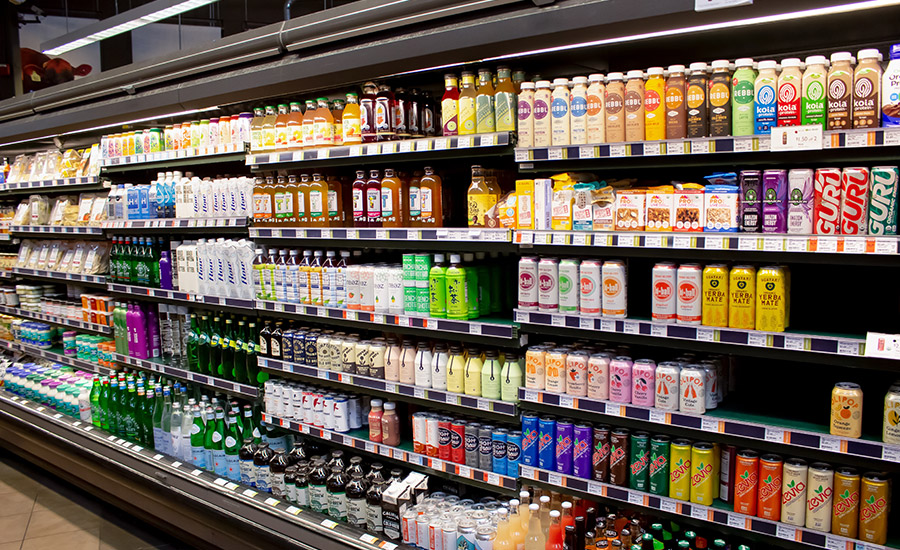It may sound like a broken record for some, but ready-to-drink (RTD) beverages have seen dollar sales increase, while unit sales decreased during the past year, a similar refrain to other dairy categories. According to Circana, a Chicago-based market research firm, tea/coffee RTD, tea/coffee refrigerated, aseptic juices, and bottled juices can all be painted with this same brush.
The outliers in the RTD beverage categories are canned juices, whose dollar sales rose 8.5% to $1.43 billion and unit sales increased by 2% to 627 million for the year ending Nov. 5. On the flip side, juice/drinks refrigerated suffered both dollar sales and unit sales declines. In this subcategory, dollar sales fell 1% to $7.8 billion, while unit sales cratered 8% to 2.25 billion, Circana data reveals.
Beyond the data, Dairy Foods takes a deep dive into what trends are currently shaping the RTD market, with the help of industry experts. For example, Sally Lyons Wyatt, global executive vice president and chief advisor, Consumer Goods and Foodservice Insights at Circana, states some of the hottest RTD coffee, tea, and juice trends include functional hydration.
“Going forward, we will see functional hydration continue to matter to consumers,” Lyons Wyatt tells Dairy Foods. “What will be interesting to watch is what benefits will capture more consumer dollars than others.”
Affordability is another trend given that many growing single-serve options are under $2. “We also see select caffeine, energy, flavors, and size offerings with positive sales,” Lyons Wyatt states. “Growing flavors include traditional options (e.g., green tea, lemon, watermelon, fruit punch) and fun and exciting (e.g., blood orange, Sno Berry, blueberry pomegranate, salted caramel, mucho mango, etc.).”
Mathew Brady, lead marketing specialist at Fenton, Mo.-based IFPC, adds specific hot sellers include cold brew coffee due to its smoother taste and higher caffeine content compared to traditional hot-brewed coffee; herbal and functional teas that offer health benefits, such as herbal teas with calming or energizing properties; and premium juices and nutrient-enhanced drinks. “Consumers are willing to pay more for high-quality, nutrient-rich juices and drinks that go beyond traditional flavors,” he says.
Lyons Wyatt notes from a size perspective, 23- and 15-ounce cans are winning unit sales with several brands, while from a channel perspective, online sales are trending positively for all except cold brew products.
Hot cold brew sales
Lisa Jackson, director of marketing for Kalamazoo, Mich.-based FlavorSum, points to data from Mintel for the North American market that shows heightened cold brew and nitro RTD coffee activity, more indulgent flavor profiles, and plant-based options.
In RTD teas, tropical flavors are becoming more prevalent, almost tripling in the past year and showing a 31% five-year compound annual growth rate. “We’ve also seen a +46% uptick in launches with claims of vitamins in RTD teas, with six in 10 calling out Vitamin C specifically,” Jackson states. “Innovation in the RTD juice category slowed about 10% in the last year, continuing the five-year decline of -13%. A recent bright spot in the RTD juice segment is nectars, beverages that offer 25-50% fruit content. Nectar innovation increased 22% last year, returning to pre-pandemic levels.
“Tropical fruit flavor profiles are resonating in nectars, with launches up 27% in the past four years,” Jackson continues. “Callouts highlighting vitamins, antioxidants, and no-added sugar are on the upswing.”
Across the RTD categories, products with the following claims are bolstering unit and dollar sales growth, adds Lyons Wyatt: Vitamin C enriched; 100 percent natural claims; no sugar claims; organic claims; and antioxidant claims (high/source/more).
Brady mentions functional ingredients first when discussing the hottest trends in RTD beverages. “Consumers are increasingly looking for beverages with added functional benefits, such as antioxidants, vitamins and adaptogens,” he notes.
Brady points to other trends as well, including low sugar and natural sweeteners due to a growing demand for healthier options; and sustainability, as environmentally conscious consumers are favoring brands that focus on sustainable sourcing, eco-friendly packaging and ethical business practices. Also trending: innovative flavors and combinations: “Unique flavor profiles and combinations, often inspired by global or exotic ingredients, have gained popularity among consumers seeking novel experiences,” he explains.
Shannon Fitzgerald, marketing manager, Human Nutrition and Health, Montvale, N.J.-based Balchem, adds bold flavors, additional benefits (wellness, energy, relaxation, nutritional, etc.), and value are hot RTD beverage trends.
“Specifically in juice, focusing on ‘free-from’ should be the baseline before adding ingredients with benefits,” Fitzgerald relays.
Demographically speaking
Another big piece of the RTD story is who consumes them, particularly since RTD beverage consumptions often varies widely among demographics. “RTD segments skew toward millennials and Gen Z,” Lyons Wyatt reveals. “New experiences is one aspect of what inspires consumers to seek these type of beverages. Other demographic highlights include RTD coffee and aseptic juice skew toward larger households and households with children are important for RTD juice drinks.”
According to Mintel, Gen Z is establishing new rules for coffee, Fitzgerald maintains. “This demographic will continue to drive RTD coffee growth and change the market. The typical hot coffee beverage is being phased out with ‘cold, flavorful coffee beverages,’” she says.
Regarding RTD tea, older consumers tend to drive consumption, with Gen Zs gravitating toward the hot tea experience. “Gen Zs look for herbal or sweeter profiles like flavored green tea with peach if they choose a ready-to-drink tea,” Jackson notes.
A desire to purchase premium RTD beverages also can vary among consumers, with inflation having an effect on many demographics. However, growing demand for premium RTD coffees, such as cold brew or vegan options “has helped insulate the segment from inflationary pressure,” Jackson suggests.
“Premium and high-quality RTD beverages have seen growth as consumers are willing to pay more for unique flavors, healthier ingredients, and sustainable packaging,” Brady adds. “Inflation may impact pricing, potentially leading some consumers to opt for more affordable options. However, the demand for premium products may persist among those prioritizing quality over price.”
Lyons Wyatt expresses similar sentiments. “We are seeing growth with some premium RTD drinks. Although it is counter-intuitive with the economic pressures, we are seeing consumers reduce their discretionary spend, but ‘splurging’ on affordable food and beverage indulgences like a premium RTD beverage,” she states. “It is a great way for reward or treat someone or yourself.”
Social media and RTDs
Considering millennials and Gen Zs are driving much of RTD beverage growth, therein lies a huge opportunity for social media to alter its landscape. “Millennials and Gen Z consumers are often seeking unique and Instagrammable experiences, driving interest in visually appealing and innovative RTD beverages,” Brady stresses.
Collaborations with influencers can significantly boost awareness and sales, especially when influencers align with the brand’s values and target demographic, Brady adds. “Encouraging user-generated content through challenges, hashtags, or contests can create a sense of community and excitement around RTD products.”
Jackson notes some recent social media campaigns have been successful, including ones for tea bombs, boba teas, and plant-based lattes, as well as Taylor Swift-inspired lavender haze lemonade. “The online innovations tap into trending health concerns, buzzy flavors, and ways to deliver indulgence,” Jackson says. “Monitoring channels like TikTok or Pinterest can inspire processors to offer a consistent and convenient RTD option for trending tastes.”
However, social media is not being leveraged to the same degree when looking at main competitors in the RTD coffee, tea, and juice segments. “Some are doing it more than others and have large numbers of followers. We have seen social media help build brand loyalists and/or fun experiences when done well,” she explains. “Therefore, it will be important for processors to identify ways to bolster their engagement with their target audiences more often.”
What the future holds
With young demographics yearning for RTD beverages and fledgling social media campaigns, one thing is likely: expect the market to change rapidly in the future.
“Affordable luxuries will continue to be a trend that will helps drive growth within these segments. However, the beverage department continues to blur, so we will see manufacturers work to refresh/reframe their offerings to drive incremental growth from younger consumers entering the category,” Circana’s Lyons Wyatt predicts. “Social media will continue to be a factor in the future of RTD coffee, tea, and juice segments. Lastly, licensing and category extensions will continue to make an impact on the category and innovation.”
Personalization could be another future hot trend, IFPC’s Brady states, which means customizable RTD beverages, allowing consumers to personalize flavors, ingredients, and nutritional content.
Also, be on the lookout for cannabis-infused beverages and smart packaging. “Depending on regulatory changes, the market for CBD or THC-infused beverages may continue to evolve,” Brady says. “[In terms of] smart packaging, integration of technology, such as QR codes for augmented reality experiences or interactive packaging, could become more prevalent.”
SIDEBAR
FlavorSum’s Jackson discusses RTD juice, RTD coffee, and RTD tea trends separately.

“For RTD juices, brands face the challenge of proving value to buyers. Pathways include the following:
- Adding functional ingredients like l-theanine for brain health or B vitamins and magnesium for energy.
- Unusual flavor combinations like passion fruit-peach can elevate the indulgent aspect of RTD juice.
- RTD juices that include health-haloed botanical ingredients or extracts can help position a brand as a tasty form of nourishing self-care.
In RTD coffee:
- We expect dessert-and-bakery-inspired flavor profiles to continue expanding in response to the demand for indulgence in RTD coffee.
- While added functionality is a smaller opportunity, some brands may increase caffeine to heighten the inherent energy benefit of RTD coffee.
- ‘Proffee,’ a current social trend where people add protein powder to coffee, may represent a niche innovation path for some brands.”
Although caffeine is the most understood energy ingredient, concern about “jitters” is leading people to explore options that could offer opportunities for RTD teas, Jackson concludes.
- “Green tea is well-liked, but ingredients like yerba mate or guayasa may become more mainstream. FlavorSum proprietary research shows that one in four North Americans are interested in beverages with guayasa, and one in three agree that yerba mate has appeal.
- Regarding functional ingredients, RTD teas can enhance energy-adjacent benefits, such as focus with ingredients like lion’s mane.
- Social listening platform Tastewise reports RTD tea flavors could highlight ginger, maple, and raspberry to align with interest in healthy, natural, and vibrant tastes.”




